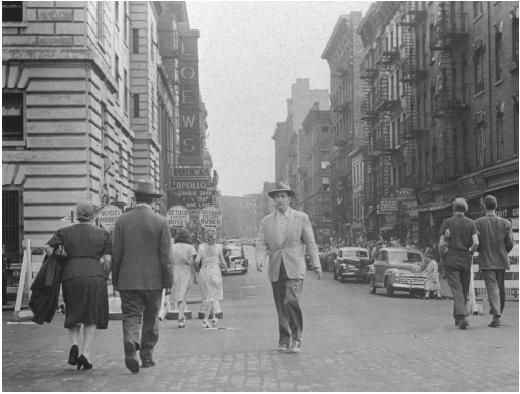The Naked City - Film (Movie) Plot and Review
USA, 1948
Director: Jules Dassin
Production: Hellinger Productions for United-International Pictures; black and white, 35mm; running time: 96 minutes. Released 4 March 1948. Filmed in Stillman's Gym, the Roxy Theater, the Whitehall Building, the City Morgue, Roosevelt Hospital, the Universal Building, and Williamsburg Bridge in New York City.
Producers: Mark Hellinger with Jules Buck; screenplay: Malvin Wald and Albert Maltz, from an unpublished story by Malvin Wald; photography: William Daniels; editor: Paul Weatherwax; sound: Leslie I. Carey and Vernon W. Kramer; art director: John F. DeCuir; set decorators: Russell Gausman and Oliver Emert; music: Miklos Rozsa and Frank Skinner; music supervisor: Milton Schwarzwald; costume designer: Grace Houston.
Cast:
Barry Fitzgerald (
Lt. Dan Muldoon
); Howard Duff (
Frank Niles
); Dorothy Hart (
Ruth Morrison
); Don Taylor (
Jimmy Halloran
); Ted De Corsia (
Garzah
); House Jameson (
Dr. Stoneman
); Anne Sargent (
Mrs. Halloran
); Adelaide Klein (
Mrs. Batory
); Grover Burgess (
Mr. Batory
); Tom Pedi (
Detective Perelli
); Enid Markey (
Mrs. Hylton
); Frank Conroy (
Captain Donahue
).
Publications
Script:
Wald, Malvin, and Albert Maltz, The Naked City , edited by Matthew J. Bruccoli, Carbondale, Illinois, 1979.
Books:
Ferrero, Adelio, Jules Dassin , Parma, 1961.
McArthur, Colin, Underworld USA , London, 1972.
Silver, Alain, and Elizabeth Ward, editors, Film Noir , Woodstock, New York, 1979.
Siclier, Fabien, and Jacques Levy, Jules Dassin , Paris, 1986.
Articles:
Variety (New York), 21 January 1948.
Brooks, Richard, on Mark Hellinger, in Screen Writer (Los Angeles), March 1948.
New York Times , 5 March 1948.
New Yorker , 13 March 1948.
Grenier, Cynthia, "Jules Dassin," in Sight and Sound (London), Winter 1957–58.
Lane, John Francis, "I See Dassin Make the Law," in Films and Filming (London), September 1958.
Dassin, Jules, "Style and Instinct," in Films and Filming (London), February and March 1970.
Martinez Carril, M., "Los vaivenes de Jules Dassin," in Cinemateca Revista (Montevideo), July 1981.
Kozloff, S., "Humanizing 'the Voice of God': Narration in The Naked City ," in Cinema Journal (Champaigne, Illinois), Summer 1984.
Reid's Film Index (Wyong), no. 5, 1990.
"Classics— The Naked City Directed by Jules Dassin," in Video Magazine (New York), vol. 16, no. 11, February 1993.
Farrell, Sean, " The Naked City ," in Scarlet Street (Glen Rock), no. 21, Winter 1996.
Lucas, Tim, " The Killers: Criss Cross: The Underneath: Brute Force: The Naked City ," in Video Watchdog (Cincinnati), no. 32, 1996.
Patterson, Troy, " The Naked City ," in Entertainment Weekly (New York), vol. 470, 5 February 1999.
Atkinson, Michael, "Shelf Life," in The Village Voice (New York), vol. 44, no. 13, 6 April 1999.
* * *
The Naked City is New York, a metropolis of playgrounds and police precincts, fire escapes and brownstones and neon lights, rush-hour subways packed like sardine cans and fire hydrants sprinkling the streets on a sweltering summer day. It is most definitely not a city constructed on a Hollywood back lot, not a set designer's stylized or otherwise exaggerated vision of Manhattan canyons. To paraphrase Mark Hellinger, the film's producer and narrator, the actors play their roles in the actual apartments, skyscrapers and city streets—107 total locations in all.
During and after World War II, several Hollywood thrillers were shot in a documentary-like manner, away from the studio in actual urban locales: The House on 92nd Street (the trendsetter, filmed in New York and released three years before The Naked City ), Panic in the Streets and Walk East on Beacon (which were shot in, respectively, New Orleans and Boston). Jules Dassin's The Naked City may not be the first of its type, but its almost revolutionary union of actors and real people, on real streets, has inspired scores of films ever since. The camera crew worked inside a van equipped with a one-way mirror, enabling them to film the city while remaining invisible to passersby. New York, and New Yorkers, become the leading performers, the film's major attraction.
The Naked City is a series of powerful scenes, first depicting the murder of a pretty, man-hungry, larcenous young model, and then detailing the efforts of the cops to sniff out her killers. Of course, they

The leading actors are familiar faces, but not stars. Except for, perhaps, Barry Fitzgerald, their names were unfamiliar to audiences. The Naked City is peopled not so much by performers as faces, everyday faces. The murder victim's parents appear in several key scenes, and the actors portraying them give heartwrenching performances. But, most importantly, they look like an anonymous couple from the New Jersey boondocks who have lost their only child to the glitter of the big city.
From Brute Force to Rififi to Never on Sunday , director Jules Dassin's career has been disconnected: The Naked City is more the cousin of The House on 92nd Street than anything else in Dassin's filmography (with the possible exception of Night and the City , shot in London). All have their roots more in Italian neorealism—or even the ashcan paintings of Robert Henri, George Bellows, John Sloan, George Luks and William Glackens—than in anything from Hollywood.
—Rob Edelman
Comment about this article, ask questions, or add new information about this topic: